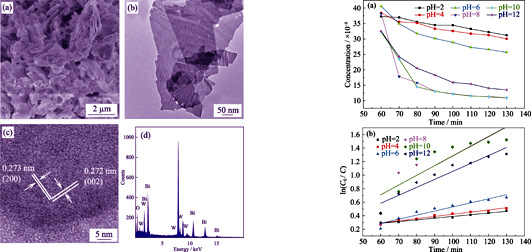

可见光下Bi2WO6纳米片高效光降解四环素的机理研究
收稿日期: 2019-07-26
修回日期: 2019-10-24
网络出版日期: 2019-10-25
基金资助
国家自然科学基金(U1607102);国家自然科学基金(21377132);国家自然科学基金(91326202);中央高校基本科研业务费专项资金(2019MS040)
Mechanism Study of Tetracycline High Efficient Photodegradation by Bi2WO6 Nanosheets under Visible Light Irradiation
Received date: 2019-07-26
Revised date: 2019-10-24
Online published: 2019-10-25
Supported by
National Natural Science Foundation of China(U1607102);National Natural Science Foundation of China(21377132);National Natural Science Foundation of China(91326202);Fundamental Research Fund for the Central Universities(2019MS040)
作为一种窄带隙半导体材料, Bi2WO6在光催化降解有机污染物上具有很大的应用潜力。研究采用水热法合成了Bi2WO6纳米片, 并在可见光照射下研究其对四环素的光催化降解。利用XRD、FESEM、TEM、吸收光谱等对材料进行结构和形貌的表征。实验发现, 在pH=8的四环素溶液中加入50 mg Bi2WO6纳米片, 可见光照射130 min 后, 85%的四环素(50 mL, 50 mg/L)被降解。实验还研究了Bi2WO6纳米片光电化学性质, 通过加入不同的自由基捕获剂研究了光催化降解四环素的反应机理。结果表明, Bi2WO6纳米片具有较高的电子密度和电子空穴分离效率是其具有良好光催化性能的原因。

魏鑫 , 卢占会 , 王路平 , 方明 . 可见光下Bi2WO6纳米片高效光降解四环素的机理研究[J]. 无机材料学报, 2020 , 35(3) : 324 -328 . DOI: 10.15541/jim20190389
As a narrow band gap semiconductor, Bi2WO6 has great application potential in photo-degradation of organic pollutants, such as tetracycline. In present work, Bi2WO6 nanosheets were successfully synthesized by a hydrothermal method and the photo-degradation of tetracycline under visible light irradiation were investigated. XRD, FESEM, TEM and absorption spectra were used to characterize the structure and morphology of the material. It was found that when adding 50 mg Bi2WO6 nanosheets into 50 mL of tetracycline solution at pH=8, 85% tetracycline (50 mL, 50 mg/L) was photodegraded within 130 min. The photoelectron-chemical experiments and free radical capture experiments were performed to explore the photo-degradation mechanism. The results show that good photocatalytic performance of Bi2WO6 nanosheets are ascribed to the high electron density and photoelectron-hole separation efficiency.

Key words: Bi2WO6 nanosheets; tetracycline; photocatalytic; visible light
| [1] | SHI LEI, LIANG LIN, MA JUN , et al. Highly efficient visible light-driven Ag/AgBr/ZnO composite photocatalyst for degrading Rhodamine B. Ceramics International, 2014,40(2):3495-3502. |
| [2] | CAO YANG, LEI XIAN-YU, CHEN QIAN-LIN , et al. Enhanced photocatalytic degradation of tetracycline hydrochloride by novel porous hollow cube ZnFe2O4. Journal of Photochemistry and Photobiology A-Chemistry, 2018,364:794-800. |
| [3] | GAO YUAN, LI YAN, ZHANG LIANG , et al. Adsorption and removal of tetracycline antibiotics from aqueous solution by graphene oxide. Journal of Colloid and Interface Science, 2012,368:5540-546. |
| [4] | ZHU MING-YU, CAI YA-WEN, LIU SHU-YA , et al. K2Ti6O13 Hybridized graphene oxide: effective enhancement in photodegradation of RhB and photoreduction of U(VI). Environmental Pollution, 2019,248:448-455. |
| [5] | FANG MING, TAN XIAO-LI . Review on the mechanism of metal surface plasmon resonance enhanced photocatalysis of semiconductor nanomaterials. Journal of Nantong University (Natural Science Edition), 2019,18(2):1-13. |
| [6] | CHEN YI-LIN, LIN BI-ZHOU, WANG SEN-LIN . Design of the open experiment for a hydrothermal synthesis of Bi2WO6 nanoplate photocatalyst. Laboratory Science, 2018,21(5):45-49. |
| [7] | XUE WEN-JING, PENG ZHI-WEI, HUANG DAN-LIAN , et al. In situ synthesis of visible-light-driven Z-scheme AgI/Bi2WO6 heterojunction photocatalysts with enhanced photocatalytic activity. Ceramics International, 2019. 45(5):6340-6349. |
| [8] | JONJANA SITTIKORN, PHURUANGRAT ANUKORN, THONGTEM TITIPUN , et al. Decolorization of Rhodamine B photocatalyzed by Ag3PO4/Bi2WO6 nanocomposites under visible radiation. Materials Letters, 2018,218:146-148. |
| [9] | QIN FEI-YU, CUI PENG-ZHEN, HU LEI , et al. Construction of multi-shelled Bi2WO6 hollow microspheres with enhanced visible light photo-catalytic performance. Materials Research Bulletin, 2018,99:331-335. |
| [10] | ZHANG ZHI-JIE, WANG WEN-ZHONG, SHANG MENG , et al. Low-temperature combustion synthesis of Bi2WO6 nanoparticles as a visible-light-driven photocatalyst. Journal of Hazardous Materials, 2010,117(1/2/3):1013-1018. |
| [11] | ZHU HONG-SHAN, TAN XIAO-LI, TAN LI-QIANG , et al. Magnetic porous polymers prepared via high internal phase emulsions for efficient removal of Pb 2+ and Cd 2+. ACS Sustainable Chemistry & Engineering, 2018,6(4):5206-5213. |
| [12] | TAN XIAO-LI, LIU GE, MEI HUI-YANG , et al. Fabrication of GO/Na2Ti3O7 composite and its efficient removal of 60 Co (II) from radioactive wastewater. Science China-Chemistry, 2019,49(1):145-154. |
| [13] | WANG XIANG-XUE, YU SHU-JUN, WANG XIANG-KE . Study on metal organic framework material in radionuclide removal. Journal of Inorganic Materials, 2019,34(1):17-26. |
| [14] | WANG XIONG, TIAN PENG, LIN YING , et al. Hierarchical nanostructures assembled from ultrathin Bi2WO6 nanoflakes and their visible-light induced photocatalytic property. Journal of Alloys and Compounds, 2015,620:228-232. |
| [15] | ZHU HONG-SHAN, YUAN JIN-YUN, TAN XIAO-LI , et al. Efficient removal of Pb2+ by Tb-MOFs: identifying the adsorption mechanism through experimental and theoretical investigations. Environmental Science: Nano, 2019,6(1):261-272. |
| [16] | WANG XIANG-XUE, CHEN LONG, WANG LIN , et al. Synthesis of novel nanomaterials and their application in efficient removal of radionuclides. Science China Chemistry, 62(8):933-967. |
| [17] | QIN JI-BO, CHEN NAN, FENG CHUAN-PING , et al. Fabrication of a novel p-n Heterojunction BiOCl/Ag6Si2O7 nanocomposite as a highly efficient and stable visible light driven photocatalyst. Materials Science & Engineering B, 2018,231:86-92. |
| [18] | WANG FEI, YANG HUA, ZHANG HAI-MIN , et al. Electrochemical performance of morphologically different Bi2WO6 nanostructures synthesized via a hydrothermal route. Journal of Electronic Materials, 2017,46(1):182-187. |
| [19] | ZHANG LI-DE, FANG MING . Nanomaterials in pollution trace detection and environmental improvement. Nano Today, 2010,5(2):128-142. |
| [20] | LIU HUI, GUO KAI, DUAN CONG-YUE , et al. A novel biosensor based on the direct electrochemistry of horseradish peroxidase immobilized in the three-dimensional flower-like Bi2WO6 microspheres. Materials Science and Engineering C, 2016,64:243-248. |
/
| 〈 |
|
〉 |